Havanna
Author: Reinhard Staupe
Publisher: Eggertspiele - Hutter Trade / Rio Grande Games / 999 Games
Year: 2009
review by

| x |
|
|
|
|
|
|
|
|
|
|
|
|
|
|
|
|
|
|
|
|
|
|
|
|
|
|
|
|
|
|
|
|
|
|
|
|
|
|
|
|
|
|
|
|
|
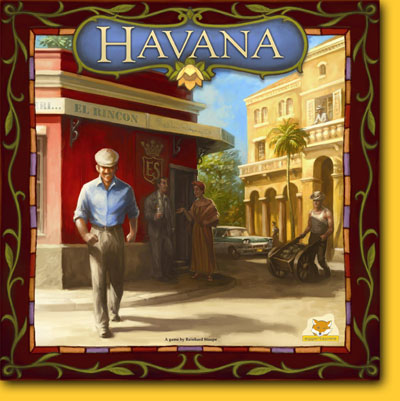 |
When the Cuban revolution ended, the capital Havana was left in a shambles. We take the responsibility to restore the city to its glorious state by erecting the most beautiful buildings. And of course these buildings bring fame and glory to the responsible contractor!
|
|
Twelve building tiles are placed on the table, in two rows of six. Each tile shows the number of points awarded to its owner, and its building costs that can consist of building material in five different colours, workers, money and often the involvement of an architect.
|
 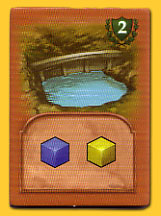 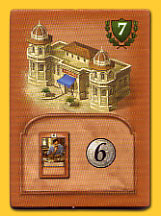 |
| x |
|
|
|
|
|
|
|
|
|
|
|
|
|
|
|
|
|
|
|
|
|
|
|
|
|
|
|
|
|
|
|
|
|
|
|
|
|
|
|
|
|
|
|
|
|
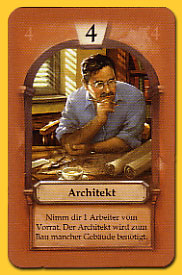 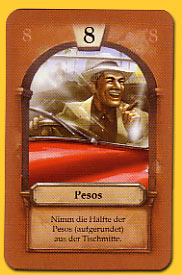 |
To collect these items the players have a set of 13 numbered character cards that enable various actions. For example, a player may take a worker from the stock, draw a building material cube from the bag, or steal money or building materials from his opponents. |
| x |
|
|
|
|
|
|
|
|
|
|
|
|
|
|
|
|
|
|
|
|
|
|
|
|
|
|
|
|
|
|
|
|
|
|
|
|
|
|
|
|
|
|
|
|
|
|
Each turn two character cards are played, and the players perform the corresponding actions. The order of play is determined by the numbers on the cards (from 0 to 9). A player who selects a 4 and a 6 has number '46' (the lowest number always comes first), and therefore he plays before a player with 79, but after players with for example 05 or 29.
|
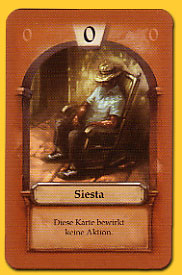  |
| x |
|
|
|
|
|
|
|
|
|
|
|
|
|
|
|
|
|
|
|
|
|
|
|
|
|
|
|
|
|
|
|
|
|
|
|
|
|
|
|
|
|
|
|
|
|
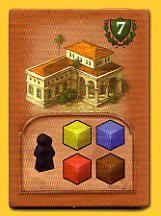 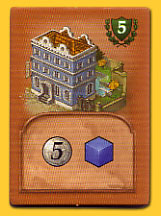 |
In addition to performing his two actions, a player may build one or more buildings. He pays the required building costs and places the building tile in front of him. But: of the twelve cards on the table, only the four cards positioned at the end of a row may be built!
When only two buildings are left in a row, the row is refilled to six from a blind stack.
|
| x |
|
|
|
|
|
|
|
|
|
|
|
|
|
|
|
|
|
|
|
|
|
|
|
|
|
|
|
|
|
|
|
|
|
|
|
|
|
|
|
|
|
|
|
|
|
|
At the end of a round all players select one new character card from their hand. This card replaces one of the two cards still in front of him from the previous turn; the replaced card goes to the discard pile.
This way, there are again two character cards in front of each player for the next round, and both actions can be performed. As long as a player does not replace a card but keeps it in front of him, he can perform the corresponding action every turn. When a player has only two character cards remaining, he may take his discard pile, and all cards are available to him again.
|
|
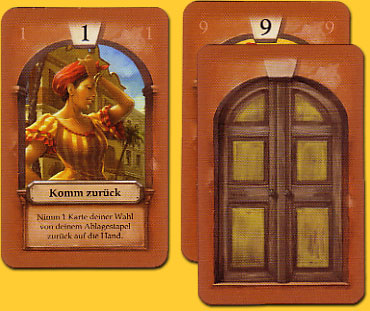 |
| x |
|
|
|
|
|
|
|
|
|
|
|
|
|
|
|
|
|
|
|
|
|
|
|
|
|
|
|
|
|
|
|
|
|
|
|
|
|
|
|
|
|
|
|
|
|
|
The game continues until a player has collected a certain number of victory points, determined by the number of players. This player wins the game.
|
| x |
|
|
|
|
|
|
|
|
|
|
|
|
|
|
|
|
|
|
|
|
|
|
|
|
|
|
|
|
|
|
|
|
|
|
|
|
|
|
|
|
|
|
|
|
|
|
|
| x |
|
|
|
|
|
|
|
|
|
|
|
|
|
|
|
|
|
|
|
|
|
|
|
|
|
|
|
|
|
|
|
|
|
|
|
|
|
|
|
|
|
|
|
|
|
| x |
|
|
|
|
|
|
|
|
|
|
|
|
|
|
|
|
|
|
|
|
|
|
|
|
|
|
|
|
|
|
|
|
|
|
|
|
|
|
|
|
|
|
|
|
|
| x |
|
|
|
|
|
|
|
|
|
|
|
|
|
|
|
|
|
|
|
|
|
|
|
|
|
|
|
|
|
|
|
|
|
|
|
|
|
|
|
|
|
|
|
|
|
 |
|
|
|
|
|
|
|
|
|
|
|
|
|
|
|
|
|
|
|
|
|
|
|
|
|
|
|
|
|
|
|
|
|
|
|
|
|
|
|
|
|
|
Who we are and what we are doing, theme-wise, is not very important. It comes down to collecting building materials and using these to erect buildings; not really an innovative concept. The interesting thing about the game is the way the character cards are played. The principle that the player order is determined by the numbers on the cards works very well; there is a 'siesta' card with the value of 0 that doesn't enable any action, but it increases the chance that the player is first in line to perform his other action and to erect buildings. Players decide every turn which actions they would like to perform, and how important it is to be the first player.
|
  |
| x |
|
|
|
|
|
|
|
|
|
|
|
|
|
|
|
|
|
|
|
|
|
|
|
|
|
|
|
|
|
|
|
|
|
|
|
|
|
|
|
|
|
|
|
|
|
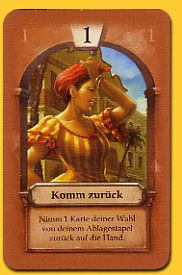 |
Depending on the strategy a player is trying to follow, not all 13 character cards will be of use to him. But luckily, it's not necessary to play all character cards before they can be used again: players can make use of the 'Come Back' character card. This character allows the player to take one card from his discard pile back into his hand. |
| x |
|
|
|
|
|
|
|
|
|
|
|
|
|
|
|
|
|
|
|
|
|
|
|
|
|
|
|
|
|
|
|
|
|
|
|
|
|
|
|
|
|
|
|
|
|
|
But this is also the weak point of the game: what if the 'Come Back' card itself ends up on the discard pile? A player then has to play all his remaining character cards, useful or not, before the discard pile becomes available again.
To prevent this from happening, players often leave the 'Come Back' card in front of them, so they may take one card from their discard pile every turn and the 'Come Back' card itself is never discarded.
|
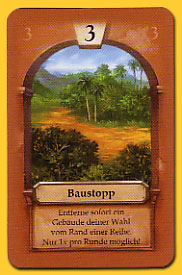 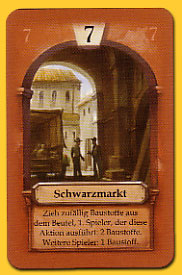 |
| x |
|
|
|
|
|
|
|
|
|
|
|
|
|
|
|
|
|
|
|
|
|
|
|
|
|
|
|
|
|
|
|
|
|
|
|
|
|
|
|
|
|
|
|
|
|
This leaves room for only one other action per turn, which makes it more difficult to react to the situation and results in a more random game. This drastically limits the strategic options Havanna pretends to offer, leaving a fair but otherwise not really special game.
© 2010 Barbara van Vugt
Havanna, Reinhard Staupe, Eggertspiele - Hutter Trade / 999 Games / Rio Grande Games, 2009 - 2 to 4 players, 10 years and up, 30-45 minutes
|
  |
|
|
|
|
|
|
|
|
|
|
|
|
|
|
|
|
|
|
|
|
|
|
|
|
|
|
|
|
|
|
|
|
|
|
|
|
|
|
|
|
|
  |
|
|
|
|
|
|
|
|
|
|
|
|
|
|
|
|
|
|
|
|
|
|
|
|
|
|
|
|
|
|
|
|
|
|
|
|
|
|
|
|
|
  |
Nice in-betweenie, but nothing special |
  |
|
|
|
|
|
|
|
|
|
|
|
|
|
|
|
|
|
|
|
|
|
|
|
|
|
|
|
|
|
|
|
|
|
|
|
|
|
|
|
|
|
  |
Swift and tactical filler without pretentions |
  |
Nice filler with some strategical choices |
| x |
|
|
|
|
|
|
|
|
|
|
|
|
|
|
|
|
|
|
|
|
|
|
|
|
|
|
|
|
|
|
|
|
|
|
|
|
|
|
|
|
|
|
|
|
|
| x |
|
|
|
|
|
|
|
|
|
|
|
|
|
|
|
|
|
|
|
|
|
|
|
|
|
|
|
|
|
|
|
|
|
|
|
|
|
|
|
|
|
|
|
|
|
 |
|
|
|
|
|
|
|
|
|
|
|
|
|
|
|
|
|
|
|
|
|
|
|
|
|
|
|
|
|
|
|
|
|
|
|
|
|
|
|
|
|
 |
|
|
|
|
|
|
|
|
|
|
|
|
|
|
|
|
|
|
|
|
|
|
|
|
|
|
|
|
|
|
|
|
|
|
|
|
|
|
|
|
|
| x |
|
|
|
|
|
|
|
|
|
|
|
|
|
|
|
|
|
|
|
|
|
|
|
|
|
|
|
|
|
|
|
|
|
|
|
|
|
|
|
|
|
|
|
|
|
 |
|
|
|
|
|
|
|
|
|
|
|
|
|
|
|
|
|
|
|
|
|
|
|
|
|
|
|
|
|
|
|
|
|
 |
|
|
|
|
|
|
|
|
|
|
|
|
|
|
|
|
|
|
|
|
|
|
|
|
|
|
|
|
|
|
|
|
|